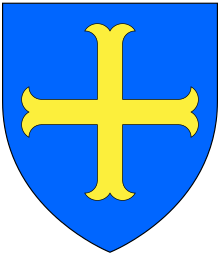Cross moline

The cross moline (also cross anchory, French croix ancrée "anchor cross") is a Christian cross, constituting a kind of heraldic cross.
History
[edit]The name derives from its shape, which resembles a millrind, the iron clamp of the upper millstone, moline being the Old French for a mill. It is very similar to one of the varieties of the "fer de moline" heraldic charge (literal French: "iron of a mill"), the forked tips of which, however, circle out slightly more, akin to the "cross recercelee". It is borne both inverted and rebated, and sometimes "saltirewise" (i.e. in the form of a saltire).
The cross moline is associated with St. Benedict of Nursia. As a result, it is widely used as an emblem by the monks and nuns of the Order of St. Benedict, which he founded.[1]
Examples
[edit]

Crosses moline appear most notably in the arms of the following:
- Families:
- Molyneux, a mediaeval Anglo-French family, Earl of Sefton, Viscount Molyneux, Molyneux baronets, etc. A famous example of canting arms: Azure, a cross moline or (Burke's Armorials, 1884)
- the House of Broglie
- Institutions:
- Modern examples:
Cercelée
[edit]

A cross cercelée, sarcelly, or recercelée is an exaggerated cross moline, and to a lesser extent similar to the anchored cross, with its forked tips curving around both ways, like a ram's horns. The form is also called recercelée, for example by Boutell.[2][3][4] Over time, English and French heralds reinterpreted the term (sometimes even treating the various spellings as multiple words with different meanings); because many crosses sarcelly were also depicted voided, some writers later used the term to mean voided, applied it to animals to mean cut in half, or applied it to bordures meaning engrailed or indented.[5][6]
See also
[edit]References
[edit]- ^ Bayne, William Wilfrid OSB ChLJ, Dom. "An American Benedictine Armorial: Part One". Order of St. Benedict. Archived from the original on 2013-12-19. Retrieved 2013-08-23.
{{cite web}}: CS1 maint: multiple names: authors list (link) - ^ Boutell, Charles. Heraldry Historical & Popular, London, 1863, p. 29
- ^
 This article incorporates text from a publication now in the public domain: Chambers, Ephraim, ed. (1728). "Cercelée". Cyclopædia, or an Universal Dictionary of Arts and Sciences (1st ed.). James and John Knapton, et al.
This article incorporates text from a publication now in the public domain: Chambers, Ephraim, ed. (1728). "Cercelée". Cyclopædia, or an Universal Dictionary of Arts and Sciences (1st ed.). James and John Knapton, et al.
- ^ Example of a cross cercelée ([1])
- ^ Henry Gough; James Parker (1894). A Glossary of Terms Used in Heraldry. p. 493.
- ^ Bradley; James Augustus Henry Murray; Murray (1914). A New English Dictionary on Historical Principles: Founded Mainly on the Materials Collected by The Philosophical Society. p. 108.
[entries "Sarcelled" and "Sarcelly"]
Sources
[edit]- Pimbley's Dictionary of Heraldry.
- Burke's Armorials. 1884.
- Boutell, Charles; Aveling, S.T. (1890). Heraldry, Ancient and Modern: Including Boutell's Heraldry. 1890. p. 42. OCLC 6102523.
- "cross moline". Merriam Webster.
Further reading
[edit]- Brooke-Little, J P, Norroy and Ulster King of Arms, An heraldic alphabet (new and revised edition), Robson Books, London, 1985 (first edition 1975); very few illustrations
- Civic Heraldry of England and Wales, fully searchable with illustrations, http://www.civicheraldry.co.uk
- Clark, Hugh (1892). An Introduction to Heraldry, 18th ed. (Revised by J. R. Planché). London: George Bell & Sons. First published 1775. ISBN 1-4325-3999-X. LCCN 26-5078
- Canadian Heraldic Authority, Public Register, with many useful official versions of modern coats of arms, searchable online http://archive.gg.ca/heraldry/pub-reg/main.asp?lang=e
- Cussans, John E. (2003). Handbook of Heraldry. Kessinger Publishing. ISBN 0-7661-7338-0. LCCN 04-24470
- Fox-Davies, Arthur Charles (1909). A Complete Guide to Heraldry. New York: Dodge Pub. Co. ISBN 0-517-26643-1. LCCN 09-23803
- Friar, Stephen (ed) A New Dictionary of Heraldry Alphabooks, Sherborne, 1987; with very few illustration of attitudes* Greaves, Kevin, A Canadian Heraldic Primer, Heraldry Society of Canada, Ottawa, 2000, lots but not enough illustrations
- Heraldry Society (England), members' arms, with illustrations of bearings, searchable online http://www.theheraldrysociety.com/
- Heraldry Society of Scotland, members' arms, fully searchable with illustrations of bearings, https://web.archive.org/web/20130507090132/http://heraldry-scotland.com/copgal/thumbnails.php?album=7
- Innes of Learney, Sir Thomas, Lord Lyon King of Arms Scots Heraldry (second edition)Oliver and Boyd, Edinburgh, 1956
- Moncreiffe of Easter Moncreiffe, Iain, Kintyre Pursuivant of Arms, and Pottinger, Don, Herald Painter Extraordinary to the Court of the Lord Lyon King of Arms Simple Heraldry, Thomas Nelson and Sons, London andf Edinburgh, 1953; splendidly illustrated
- Neubecker, Ottfried (1976). Heraldry: Sources, Symbols and Meaning. Maidenhead, England: McGraw-Hill. ISBN 0-07-046312-3.
- Royal Heraldry Society of Canada, Members' Roll of Arms, with illustrations of bearings, searchable online http://www.heraldry.ca/
- South African Bureau of Heraldry, data on registered heraldic representations (part of National Archives of South Africa); searchable online (but no illustration), http://www.national.archsrch.gov.za/sm300cv/smws/sm300dl
- Volborth, Carl-Alexander von (1981). Heraldry: Customs, Rules and Styles. Poole, England: Blandford Press. ISBN 0-7137-0940-5. LCCN 81-670212
- Woodcock, Thomas and John Martin Robinson (1988). The Oxford Guide to Heraldry. Oxford: University Press. ISBN 0-19-211658-4. LCCN 88-23554
- Woodward, John and George Burnett (1969). Woodward's a treatise on heraldry, British and foreign. Originally published 1892, Edinburgh: W. & A. B. Johnson. ISBN 0-7153-4464-1. LCCN 02-20303.

